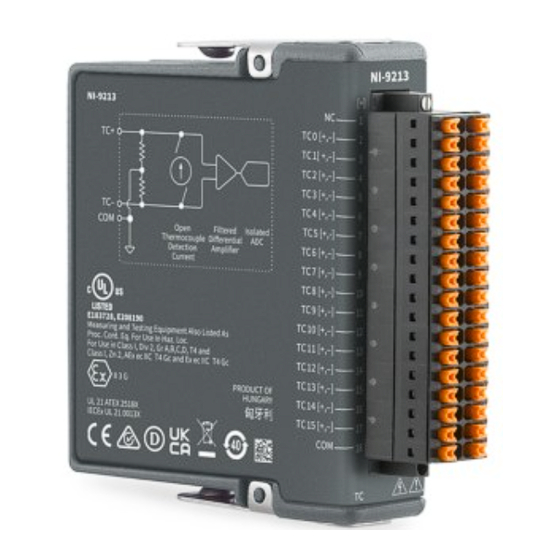
Table of Contents
Advertisement
Quick Links
Advertisement
Table of Contents

Summary of Contents for NI 9213
- Page 1 NI-9213...
- Page 2 GETTING STARTED GUIDE NI 9213 16 TC, ±78 mV, 24 Bit, 75 S/s Aggregate...
-
Page 3: Safety Guidelines
This document explains how to connect to the NI 9213. Before you begin, complete the software and Note hardware installation procedures in your chassis documentation. The guidelines in this document are specific to Note the NI 9213. The other components in the system might not meet the same safety ratings. -
Page 4: Safety Voltages
4,000 m dielectric withstand test Measurement Category II is for measurements performed on circuits directly connected to the electrical distribution system. This category refers to local-level electrical distribution, such as NI 9213 Getting Started Guide | © National Instruments | 3... -
Page 5: Safety Guidelines For Hazardous Voltages
115 V for U.S. or 230 V for Europe. Do not connect the NI 9213 to signals or use Caution for measurements within Measurement Categories III or IV. Safety Guidelines for Hazardous Voltages If hazardous voltages are connected to the device, take the following precautions. -
Page 6: Safety Guidelines For Hazardous Locations
Safety Guidelines for Hazardous Locations The NI 9213 is suitable for use in Class I, Division 2, Groups A, B, C, D, T4 hazardous locations; Class I, Zone 2, AEx nA IIC T4 and Ex nA IIC T4 hazardous locations; and nonhazardous locations only. - Page 7 II 3G and is suitable for use in Zone 2 hazardous locations, in ambient temperatures of -40 °C ≤ Ta ≤ 70 °C. If you are using the NI 9213 in Gas Group IIC hazardous locations, you must use the device in an NI chassis that has been evaluated as Ex nC IIC T4, Ex IIC T4, Ex nA IIC T4, or Ex nL IIC T4 equipment.
-
Page 8: Electromagnetic Compatibility Guidelines
This product is intended for use in industrial locations. However, harmful interference may occur in some installations, when the product is connected to a peripheral device or test object, or if the NI 9213 Getting Started Guide | © National Instruments | 7... -
Page 9: Special Conditions For Marine Applications
Some products are Lloyd’s Register (LR) Type Approved for marine (shipboard) applications. To verify Lloyd’s Register certification for a product, visit and search ni.com/certification for the LR certificate, or look for the Lloyd’s Register mark on the product. 8 | ni.com | NI 9213 Getting Started Guide... -
Page 10: Preparing The Environment
EMC performance is attained. Preparing the Environment Ensure that the environment in which you are using the NI 9213 meets the following specifications. Operating temperature -40 °C to 70 °C... - Page 11 Refer to the device datasheet on ni.com/manuals Note for complete specifications. 10 | ni.com | NI 9213 Getting Started Guide...
- Page 12 TC1– TC2– TC2+ TC3– TC3+ TC4– TC4+ TC5+ TC5– TC6– TC6+ TC7+ TC7– TC8– TC8+ TC9+ TC9– TC10– TC10+ TC11– TC11+ TC12– TC12+ TC13– TC13+ TC14+ TC14– TC15– TC15+ NI 9213 Getting Started Guide | © National Instruments | 11...
-
Page 13: Thermocouple Connections
Table 1. Signal Descriptions Signal Description Common reference connection No connection Positive thermocouple connection Negative thermocouple connection Thermocouple Connections Shield Thermocouple TC– NI 9213 reference 12 | ni.com | NI 9213 Getting Started Guide... -
Page 14: Minimizing Thermal Gradients
Minimize adjacent heat sources and air flow across the terminals. • Keep the ambient temperature as stable as possible. • Make sure the NI 9213 terminals are facing forward or upward. NI 9213 Getting Started Guide | © National Instruments | 13... -
Page 15: Ni 9213 Connection Guidelines
• Use the NI 9940 backshell kit. NI 9213 Connection Guidelines • Make sure that devices you connect to the NI 9213 are compatible with the module specifications. • You must use 2-wire ferrules to create a secure connection when connecting more than one wire to a single terminal on the NI 9213. -
Page 16: High-Vibration Application Connections
High-Vibration Application Connections If your application is subject to high vibration, NI recommends that you use the NI 9940 backshell kit to protect connections to the NI 9213. Overvoltage Protection The NI 9213 provides overvoltage protection between any two inputs. -
Page 17: Where To Go Next
NI 9213 Datasheet NI 9213 Datasheet NI-RIO Help NI-DAQmx Help LabVIEW FPGA Help LabVIEW Help RELATED INFORMATION C Series Documentation Services & Resources ni.com/services ni.com/info cseriesdoc Located at ni.com/manuals Installs with the software 16 | ni.com | NI 9213 Getting Started Guide... -
Page 18: Worldwide Support And Services
You can obtain the DoC for your product by visiting ni.com/certification. If your product supports calibration, you can obtain the calibration certificate for your product at ni.com/calibration. NI 9213 Getting Started Guide | © National Instruments | 17... - Page 19 National Instruments Patent Notice at . You can find information about end-user license agreements (EULAs) and third-party legal notices in the readme file for your NI product. ni.com/legal/export-compliance Refer to the Export Compliance Information at for the NI global trade compliance policy and how to obtain relevant HTS codes, ECCNs, and other import/ export data.













Need help?
Do you have a question about the 9213 and is the answer not in the manual?
Questions and answers